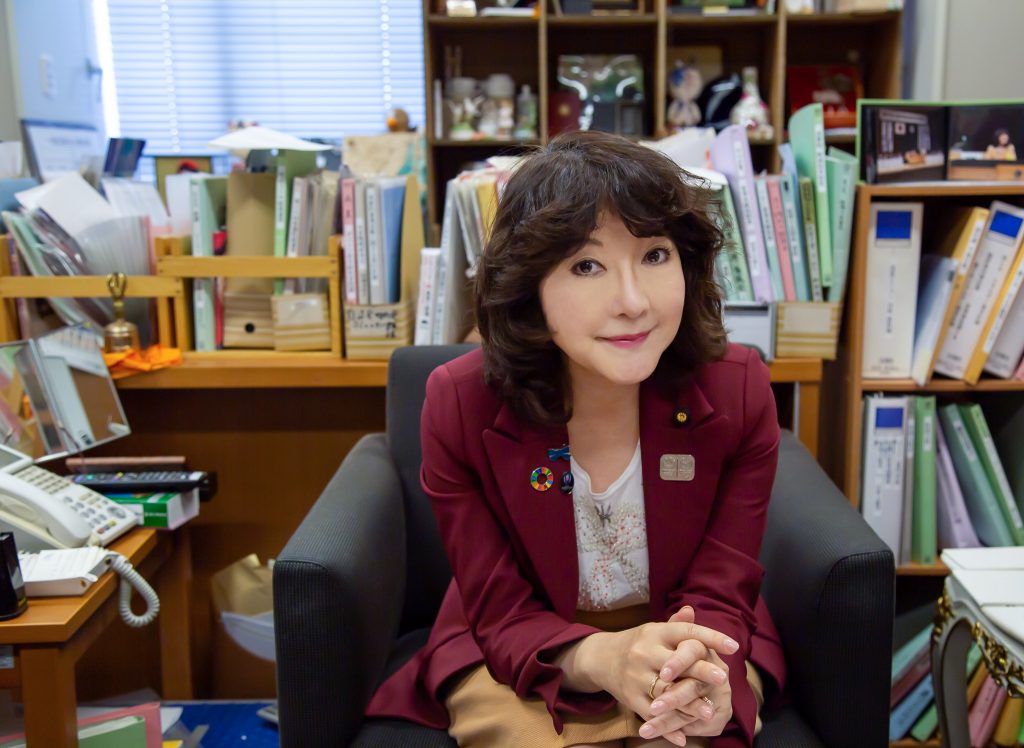 Three years have passed since the SDGs came into force on January 1, 2016 and slowly but surely, they are gaining recognition. Meanwhile, new challenges are unfolding and need to be addressed.
Three years have passed since the SDGs came into force on January 1, 2016 and slowly but surely, they are gaining recognition. Meanwhile, new challenges are unfolding and need to be addressed.
In our inaugural interview, SDGs Japan Portal speaks to Satsuki Katayama, who is promoting regional revitalization and gender equality as part of her role as the Minister of State for Special Missions in the fourth Abe cabinet. With such issues on her agenda, you could say that she lives and breathes the SDGs. We wanted to find out more about the significance and impact of these goals.
The SDGs as a framework for success
SDGs Japan Portal: Japan faces myriad problems in the wake of its low birthrate and ageing population. Rural communities shrink and fall apart, while SMEs with no successors to take over are forced to close. What solutions do the SDGs offer Japan in such circumstances?
Satsuki Katayama: The SDGs are in essence an action plan for the future, at the global level. The fact is that the problems Japan is facing right now are those that the rest of the world too will experience in the future. In that sense, Japan is on the frontline and the whole world is watching to see how we solve these issues. It’s true that the population of some countries continues to grow exponentially. But Japan as a developed country needs to confront the position it is in head-on, take responsibility and mature through it.
There are environmental problems to solved, and the number of young people who play a leading role is steadily decreasing…but the SDGs are perfect for overcoming these sorts of challenges. One reason for this is that is revolves around the economy. Sustainability is inevitably connected to industry. Some people wonder whether simply trying to protect the environment will cause the economy to contract, while others ask whether it is really acceptable to keep destroying the environment in the name of economic growth. We need to embrace these conflicting ideas in order to forge a better future for our society. This is the concept upon which the SDGs were created.
The SDGs as a knowledge resource for resilient regions
“Regional revitalization” is a hot topic in Japan nowadays. What do you think is the relationship between SDGs and regional revitalization?
Regional revitalization is one of my responsibilities as Minister of State for Special Missions of the Cabinet Office. I have always felt that SDGs are inseparable from this issue. While the population declines in rural areas, urbanization increases. The SDGs are indispensable to efforts to the create of work in rural areas, an environment where you can raise children with peace of mind, and ultimately encourage migration to these areas.
We worked to create a framework to adapt the SDGs to the circumstances in Japan, part of which is the “SDGs Action Plan,” which is based on three pillars:
- Promotion of “Society 5.0,” a blueprint for a smarter society, which goes hand in hand with the SDGs
- Regional revitalization driven by SDGs that centers on planning attractive, resilient and environmentally-friendly towns
- Empowerment of the next-generation women as the standard bearers of the SDGs
This is coupled together with eight principles:
- Inclusion and participation of all
- Health and longevity for all
- Creation of growth markets, regional revitalization, science and technology innovation
- Sustainable and resilient land development and high-quality infrastructure
- Energy conservation and renewable energy development, development of climate change countermeasures, transition to a recycling-oriented society
- Conservation of environment including forest and ocean environments, biodiversity
- Realization of peaceful and safe society
- System and means of promoting SDGs implementation
Regional revitalization is one of the most important issues in this framework. We have launched the designation of “SDG Future Cities” and actively provided financial support through public-private partnerships for the realization of model SDG projects. Currently, 60 local authorities have been selected for the designation and what’s more, 829 organizations are participating in the “Regional Revitalization SDGs Public-Private Partnership Platform.” We are already working on an expanded version of the SDGs Action Plan for 2019.
I truly believe Japan will only flourish when these regions are given a chance to themselves. The SDGs are the catalyst to make this reality.
This interview is the first instalment in a three-part series. It has been adapted from the original Japanese at: https://japan-sdgs.or.jp/news/117.html




